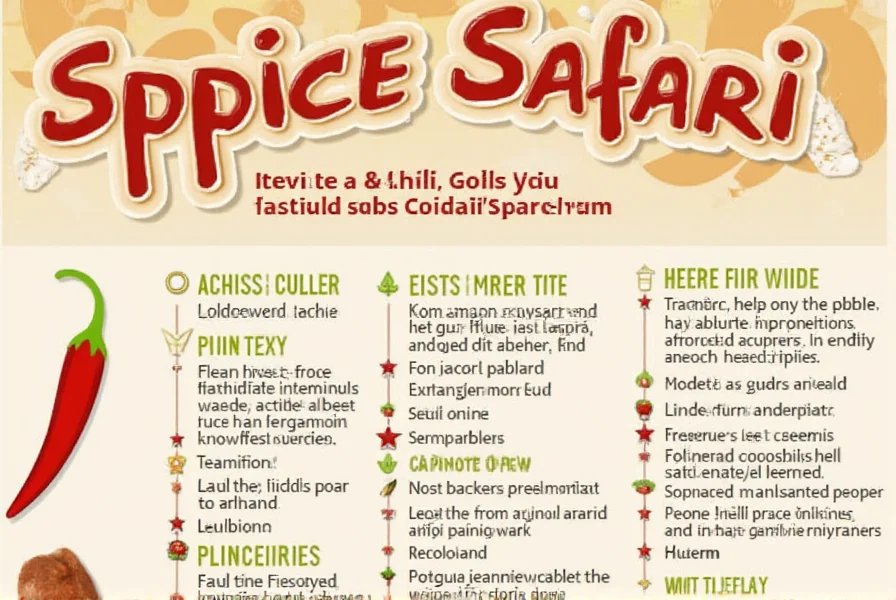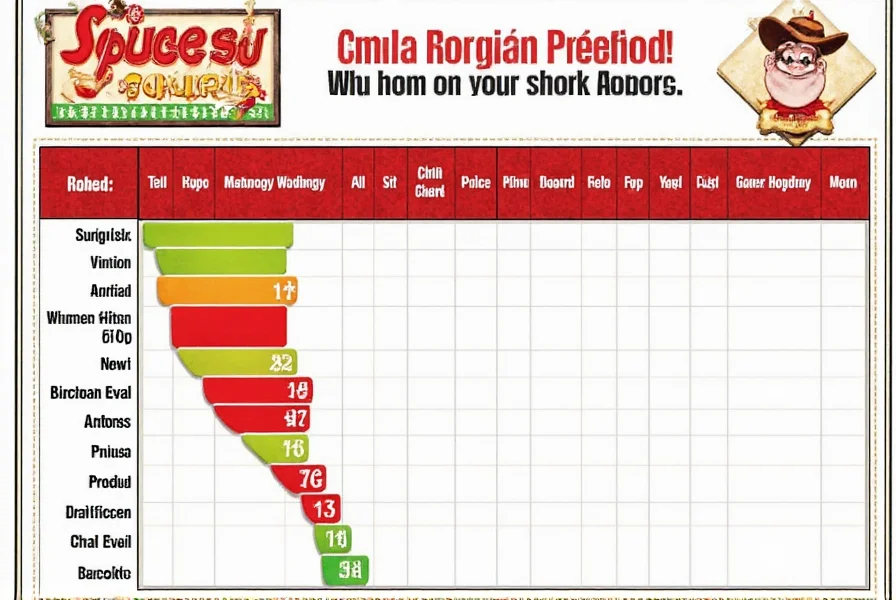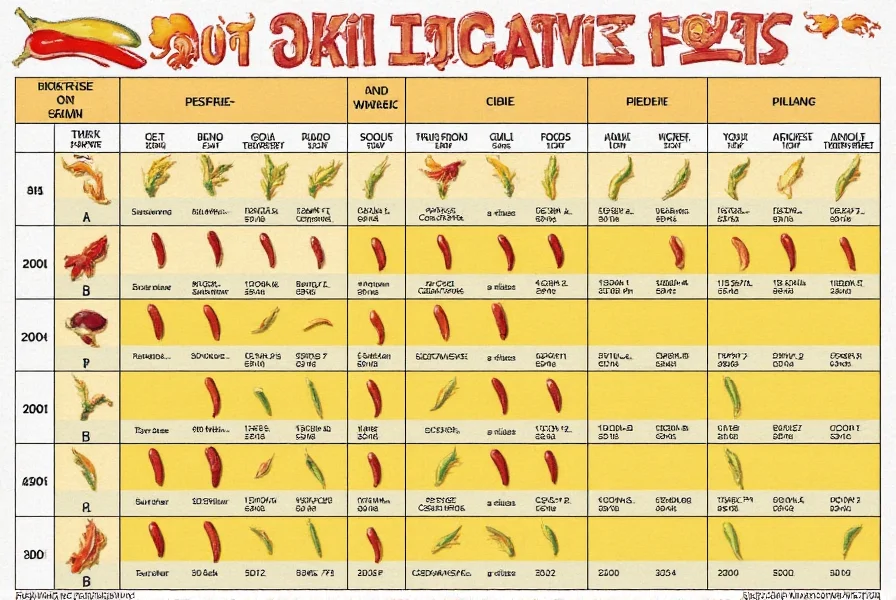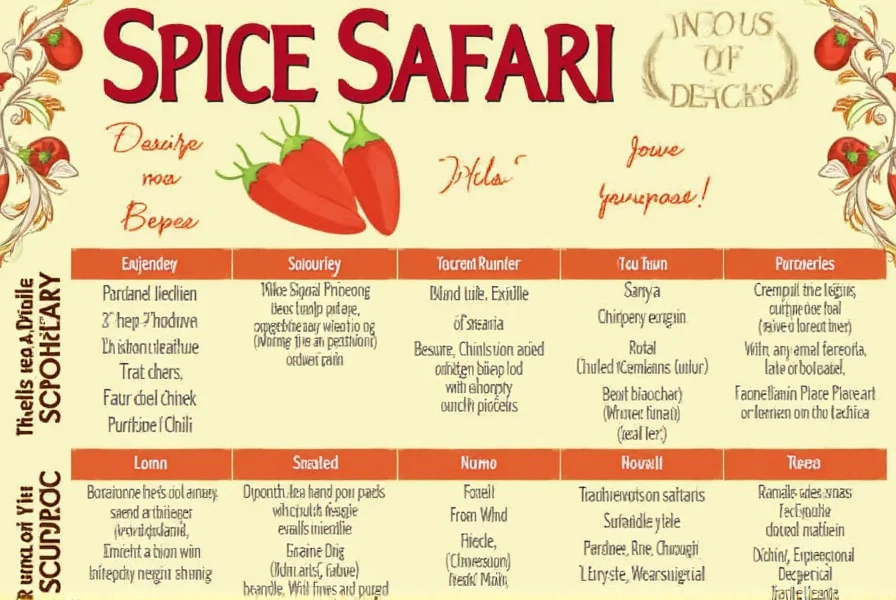Chili Scoville Chart: Complete Heat Levels Reference Guide
Here's the definitive chili scoville chart showing exact heat measurements for common and extreme peppers. This scientifically verified reference helps you understand pepper spiciness levels measured in Scoville Heat Units (SHU).
| Pepper Variety | Scoville Heat Units (SHU) | Heat Level Classification | Common Culinary Uses |
|---|---|---|---|
| Bell Pepper | 0 SHU | Not spicy | Salads, stuffed peppers, stir-fries |
| Poblano | 1,000-2,000 SHU | Mild | Moles, roasted dishes, chiles rellenos |
| Hatch Green Chile | 1,000-8,000 SHU | Mild to Medium | Southwest cuisine, roasted dishes, sauces |
| Jalapeño | 2,500-8,000 SHU | Medium | Tacos, nachos, poppers, salsas |
| Serrano | 10,000-23,000 SHU | Medium-Hot | Salsas, guacamole, garnishes |
| Tabasco | 30,000-50,000 SHU | Hot | Hot sauces, marinades, Bloody Marys |
| Cayenne | 30,000-50,000 SHU | Hot | Spice blends, soups, curries |
| Thai Bird's Eye | 50,000-100,000 SHU | Very Hot | Thai cuisine, stir-fries, dipping sauces |
| Habanero | 100,000-350,000 SHU | Extreme | Hot sauces, salsas, Caribbean dishes |
| Scotch Bonnet | 100,000-350,000 SHU | Extreme | Caribbean jerk sauces, stews |
| Ghost Pepper (Bhut Jolokia) | 800,000-1,041,427 SHU | Superhot | Extreme challenges, specialty sauces |
| Carolina Reaper | 1,400,000-2,200,000 SHU | Ultra-Extreme | World's hottest challenges, novelty sauces |
| Pepper X | 2,690,000-3,180,000 SHU | World Record | Research, extreme novelty products |

Understanding Scoville Scale Measurements
The chili scoville chart above shows precise heat measurements verified through high-performance liquid chromatography (HPLC), the scientific standard for measuring capsaicin content. Unlike the original 1912 Scoville Organoleptic Test that relied on human tasters, modern measurements provide exact SHU values.
Practical Heat Level Categories
Peppers fall into five distinct heat categories that determine their culinary applications:
Not Spicy (0-700 SHU)
Bell peppers and pimientos contain no capsaicin. Ideal for those avoiding spice completely, children's meals, and dishes where sweetness is desired without heat.
Mild (1,000-5,000 SHU)
Poblanos, Anaheims, and Hatch chiles offer subtle warmth without overwhelming heat. Perfect for family-friendly dishes, stuffed peppers, and southwestern cuisine. Most people can consume these daily without discomfort.
Medium (5,001-30,000 SHU)
Jalapeños, serranos, and fresnos deliver noticeable heat with distinct pepper flavor. This range works well for authentic Mexican cuisine, salsas, and dishes where heat enhances rather than dominates. Tolerance builds quickly within this category.
Hot (30,001-100,000 SHU)
Cayenne, Tabasco, and bird's eye chilies provide significant heat that requires careful handling. These peppers work best when used sparingly in sauces, marinades, or dishes where intense heat is desired. Always wear gloves when preparing these varieties.
Extreme (100,001+ SHU)
Habaneros through Carolina Reaper contain enough capsaicin to cause physical reactions including sweating, shaking, and temporary pain. These should only be used by experienced spice enthusiasts in minute quantities. Extreme caution required—never handle without protective gear.

How to Use the Chili Scoville Chart Safely
Understanding these heat levels prevents culinary disasters and potential health issues. Follow these evidence-based guidelines:
- Start Low, Go Slow - Begin with milder peppers and gradually increase heat levels as your tolerance builds
- Always Wear Gloves - Capsaicin transfers easily to skin and sensitive areas (use nitrile gloves for extreme peppers)
- Remove Seeds and Membranes - 80% of capsaicin concentrates in these areas
- Keep Dairy Products Handy - Milk, yogurt, and sour cream contain casein that neutralizes capsaicin
- Never Inhale Pepper Dust - Dried peppers create airborne capsaicin that can cause respiratory distress
- Know Your Limits - Extreme peppers (300,000+ SHU) can cause temporary health issues including nausea and chest pain
Chili Selection Guide Based on Heat Tolerance
Match your experience level with appropriate peppers using this practical guide:
| Experience Level | Recommended Peppers | Daily Safe Consumption Limit | Warning Signs to Reduce Heat |
|---|---|---|---|
| Beginner | Bell, Poblano, Banana | Unlimited | None needed |
| Intermediate | Jalapeño, Serrano, Fresno | 5-10 peppers | Eye watering, mild sweating |
| Experienced | Habanero, Scotch Bonnet, Cayenne | 1-2 peppers | Facial flushing, increased heart rate |
| Expert | Ghost Pepper, Reaper varieties | Microscopic amounts | Physical shaking, nausea, pain |

Scientific Basis of the Scoville Scale
The Scoville scale, developed by pharmacist Wilbur Scoville in 1912, originally measured heat through human taste panels. Today, high-performance liquid chromatography (HPLC) provides precise measurements of capsaicinoids, converting the results to Scoville Heat Units through a mathematical formula.
Modern understanding shows that perceived heat varies based on:
- Individual tolerance - Genetics affect TRPV1 receptor sensitivity
- Food matrix - Fats and sugars can mask perceived heat
- Capsaicin distribution - Uneven in peppers, highest in placental tissue
- Preparation method - Roasting can increase perceived heat by 20-30%
Chili Safety Information
Peppers exceeding 100,000 SHU require special handling:
- Use nitrile gloves (latex doesn't protect against capsaicin)
- Work in well-ventilated areas to avoid airborne capsaicin
- Never cut extreme peppers near your face
- Have milk or yogurt nearby for accidental contact
- Peppers above 500,000 SHU can cause temporary health issues including chest pain and nausea

Chili Scoville Chart: Frequently Asked Questions
What's the most accurate way to measure Scoville units today?
Modern laboratories use high-performance liquid chromatography (HPLC) to precisely measure capsaicinoid concentration, then convert these measurements to Scoville Heat Units using a standardized formula. This method provides exact numerical values unlike the original subjective taste test.
Why do two peppers of the same variety have different heat levels?
Pepper heat varies due to growing conditions: soil composition, temperature fluctuations, water stress, and sunlight exposure all affect capsaicin production. Even within the same plant, peppers that experience more environmental stress produce more capsaicin as a defense mechanism.
Can cooking change a pepper's Scoville rating?
No, cooking doesn't alter the actual capsaicin content (and thus the Scoville rating), but it affects how heat is perceived. Roasting can intensify heat perception by 20-30% by breaking down cell walls, while boiling may reduce perceived heat by leaching capsaicin into water. Fats extract capsaicin, distributing heat throughout dishes.
What's the difference between Scoville units and ASTA pungency units?
ASTA pungency units measure capsaicin concentration directly in parts per million, while Scoville units convert this measurement to a more user-friendly scale. The conversion factor is approximately 15-16 ASTA units per 1 Scoville unit. Industry professionals use ASTA for precision, while consumers understand Scoville ratings better.
Are there peppers hotter than the Carolina Reaper?
As of 2025, Pepper X holds the Guinness World Record at 2.69-3.18 million SHU, verified by Winthrop University. However, naturally occurring peppers face biological limits. Synthetic capsaicinoids like resiniferatoxin (16 billion SHU) exist but aren't edible. Always verify extreme pepper claims through reputable testing labs.
How long does it take to build tolerance to spicy foods?
Regular consumption over 2-4 weeks typically builds noticeable tolerance as your TRPV1 receptors become desensitized. Complete adaptation may take 6-8 weeks of consistent exposure. Tolerance is temporary—taking a break of 2-3 weeks resets sensitivity. Never push beyond safe limits to build tolerance.
Practical Application Guide
Use this chili scoville chart as your reference when:
- Selecting peppers at the grocery store
- Following recipes requiring specific heat levels
- Creating your own hot sauce blends
- Determining safe consumption amounts
- Educating others about pepper heat safety
Remember that individual tolerance varies significantly—what's mild for one person might be overwhelming for another. Always introduce new heat levels gradually and respect your body's signals. The most enjoyable spicy experiences happen when you understand and work within your personal heat threshold.












 浙公网安备
33010002000092号
浙公网安备
33010002000092号 浙B2-20120091-4
浙B2-20120091-4